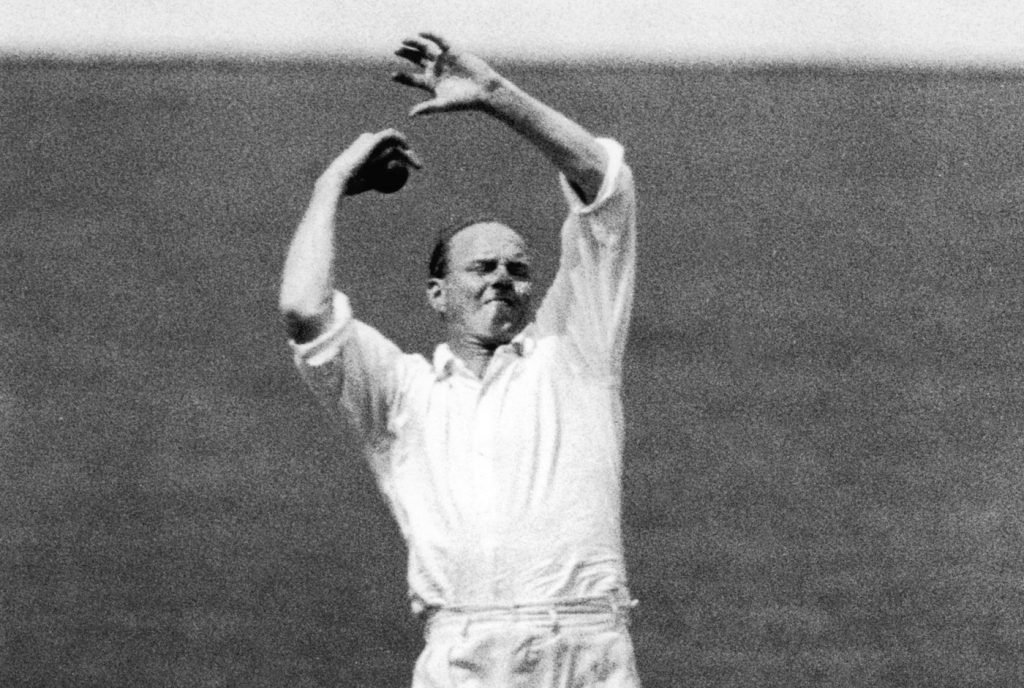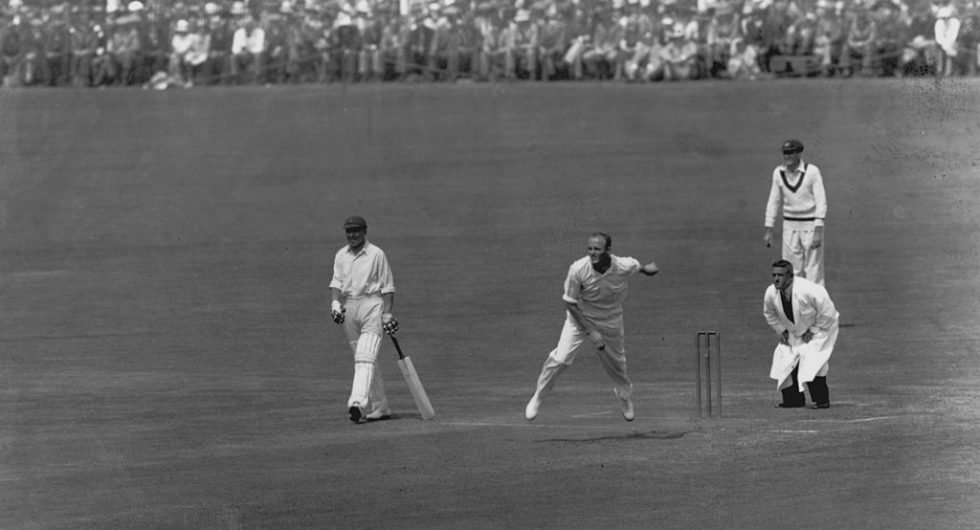Sadly, Bill O’Reilly’s test career was quite short. The circumstances conspired against his early recognition as a major talent, and the Second World War effectively cut him off from international cricket at the age of only 32. But he nevertheless made an unforgettable impact.
William Joseph O’Reilly was born on December 20, 1905, in the mining town of White Cliffs, New South Wales. He made his first-class debut in 1927–28 but could not show his class by taking only seven wickets. Although, by profession, he was a teacher, he could not play cricket in the next four seasons. In 1931, he got a chance to play cricket again, and his satisfactory performance opened the doors to the Test level. He made his Test debut against South Africa at Adelaide and took 2 for 74 and 2 for 81.
Don Bradman, who played against him in state cricket and alongside him in most of his Test matches, said O’Reilly was the best bowler he ever faced and the best bowler he ever saw. Wally Hammond, who opposed him in all 19 of the Tests he played against England, said O’Reilly made the ball jump off the pitch better than any other slow bowler he had met.
Bill O’Reilly’s height was a key factor in his success. A tall 6ft 2 inch, he was a spin bowler and approached the wicket with a bounding run. He possessed the build and temperament of a fast bowler. His ultra-aggressive manner took opponents and teammates alike aback, earning him the nickname ‘Tiger’.
Every ball he bowled was charged with hostility, and he had an appeal that could make batsmen jump out of their skin. ‘Hitting Bill O’Reilly for four was like disturbing a hive of bees,’ Bradman said. O’Reilly’s sheer unorthodoxy was one of the reasons why some people were slow to believe in him.
Bill O’Reilly gripped the ball in an unusual fashion and rejected the received wisdom that a leg-spinner should bowl to an array of close catchers on the leg side, preferring to target the stumps. In his way, he challenged perceptions about leg-spin bowling every bit as much as Shane Warne did later.
When O’Reilly died in 1992, Wisden, among others, hailed him as the greatest spin bowler the game had produced. As it happened, that was the year that Warne, who must be considered his greatest rival for that title, made his debut for Australia against India.

Although they did not oppose each other often in first-class cricket—they played together for New South Wales before Bradman moved to South Australia—O’Reilly dismissed Bradman six times and also, on one famous occasion, during a testimonial match in Sydney in which Bradman had been due to bat at number 3, but O’Reilly was bowling a devastating spell that prompted him to drop himself three places down the order (Bradman went on to score a double century).
Bill O’Reilly also had an excellent record against Hammond, England’s leading batsman, whom he dismissed seven times for scores of 26 or fewer. Test cricket was a batsman’s game in the 1930s. Therefore, there are timeless matches in Australia, feathered pitches there, and often in England too. And it is in this context that bowling records must be assessed.
Considering the one-off Test he played for Australia straight after the Second World War, O’Reilly’s figures of 144 wickets in 27 Tests at 22.59 bear comparison with anyone else’s during this period. Only Clarrie Grimmett, his leg-spinning ally in the Australian team, and Maurice Tate of England took more wickets, both at higher averages.
However, Hedley Verity, England’s left-arm spinner, also took 144 wickets, but again at a higher average. In Ashes Tests, only Grimmett, with 106 wickets to O’Reilly’s 102, took more wickets, bowled many more overs, and averaged 32.44, whereas O’Reilly’s figure was 25.36, remarkably low considering the conditions.
O’Reilly could bowl well on any sort of pitch. It has always been reckoned that the English climate and English surfaces don’t favor leg-spinners. But O’Reilly (and Warne) blew sizeable holes in that argument. O’Reilly was superb in England on his two tours, taking more than 100 wickets both times at around 17 runs apiece.
While in the Tests, he captured 28 wickets in 1934 and 22 in 1938 (when only four matches were played due to rain washing out the game in Manchester). He was the leading wicket-taker on either side on both occasions and played a starring role in two of the three matches Australia won.
In the first Test at Trent Bridge in 1934, he bowled his side to victory with only ten minutes left on the clock on the final day, with figures of seven for 54; at Headingley in 1938, he took 10 for 122 in the match. His victims included Hammond in both innings, the second time for a first-ball duck courtesy of a googly.
When there really was nothing on the pitch, he could contain it better than almost anyone. At the Oval in 1938, when Len Hutton made his 364 in an England total of 903 for seven, O’Reilly still managed to wheel down 85 overs for only 178 runs. O’Reilly took more than 20 wickets in each of the five full series he played, four against England and one against South Africa.
His part in the 1932–33 Ashes series has largely been forgotten because of the controversy over England’s bodyline tactics and the fact England won 4–1, but O’Reilly’s contribution was immense. He took ten wickets in the one game Australia won and got through an enormous amount of work, bowling 383.4 overs in the five matches while conceding fewer than 1.90 runs per over.
It was a warning of what was to come. O’Reilly bowled with a lot of variety. His leg break was a big weapon. Bradman said it was hard to imagine anyone could bowl a nastier one. But he also possessed top-spinners and googlies, plus a viciously faster ball. England’s Maurice Leyland said the first over he received from O’Reilly, which was in the days of eight-ball overs in Australia, contained eight different deliveries.
Bill O’Reilly grew up in rural New South Wales. He moved to Sydney at the age of 18 to follow his father into teaching, and there began a remarkable career in grade cricket. That would see him take almost 1,000 wickets at an average of 9.44. He failed a state trial when he was 20.
However, he played three games for the state in 1927–28, when he turned 22. Unfortunately, teaching then took him away from the city again for three years, during which he developed his googly. He did not establish himself in the NSW side until 1931–32, after taking five wickets. Also, including that of Australia captain Bill Woodfull, in his second match of the season.
Within weeks, he was playing for Australia and bowling 81.4 overs on his first appearance. During that match, he failed to appeal for LBW, and the umpire later informed him that had he appealed, he would have given the batsman out. O’Reilly made sure he didn’t make that mistake again.
Bill O’Reilly put up a consistent performance, but unfortunately, he missed eight years of cricket due to the Second World War; otherwise, his records would have been more impressive. After that, he played only one game against New Zealand in 1946, which turned out to be his final appearance in Test cricket for Australia. He took 5 for 14 and 3 for 19 in that game at Wellington.
In all First-Class cricket, he had 774 wickets in just 135 matches at an average of a mere 16.60 with the best of 9 for 38, including 63 times five wickets haul and 17 times ten wickets in a match. These stats clearly show how he was called the greatest leg-spin bowler in Australian history, along with Shane Warne.
After retirement, Bill O’Reilly was considered a respectable writer and broadcaster. He served as a columnist for the Sydney Morning Herald until 1988, when his health retreated. He was a keen broadcaster and served his services until his death in 1992 at the age of 87.

- Read More
- Doug Ring – The Member of Invincible Team
- Don Bradman Australia, 1928 – 1948
- Bill Johnston – Bradman Invincible Bowler
- Gil Langley – Former Australian Wicket Keeper
- Victor Trumper – The Greatest Batsman of Golden Age
- 50,000 Runs in all forms of cricket
- Richie Benaud Australia, 1952 – 1964
- Ray Lindwall, Australian Premier Fast Bowler 1946–60
- Jeff Thomson, Australia 1972–85
- Adam Gilchrist – The Greatest Wicket Keeper Batsman
- Keith Miller, Australia, 1946-1956